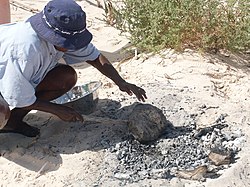Bush bread
 Damper being prepared in hot coals | |
| Alternative names | Seedcakes |
|---|---|
| Type | Bread |
| Place of origin | Australia |
| Region or state | Aboriginal |
| Main ingredients | Flour (from various seeds), water |
Bush bread, or seedcakes, refers to the bread made by Aboriginal Australians by crushing seeds into a dough that is then baked. The bread is high in protein and carbohydrate, and forms part of a balanced traditional diet.[1] It is also sometimes referred to as damper,[2] although damper is more commonly used to describe the bread made by non-Indigenous people.
With the arrival of Europeans and pre-
Bread-making was a woman's task. It was generally carried out by several women at once, due to its
Bread-making from seeds

Collecting the seed
Seeds varied depending on the time of year and the area in Australia that the people lived. In Central Australia,
Women harvested the fully ripe, dry seeds of the plant by beating the grass (or pod-laden trees in the case of wattleseed) with sticks to dislodge the seeds. Some species were eaten at the green stage and, when ground, would produce a juice at the side of the millstone, which was drunk directly.
Some seeds (such as the seed of acacia) need to be heated, hulled and then ground dry, while others (such as those of grasses) can be ground with water.[3]
In the
Other seeds used
Pigwig (Portulaca oleracea), prickly wattle (Acacia victoriae), mulga (Acacia aneura), dead finish seed (Acacia tetragonophylla), and bush bean (Vincetoxicum lineare) are also occasionally used in the making of bush bread.
Making the flour
After the grain was collected, it needed to be winnowed, which was done using the coolamon, the multi-purpose carrying vessel. Sometimes it needed to be winnowed several times.
Once the grain was winnowed, it was ground using a millstone, to create flour. Millstones have been discovered which have proven to be as old as 50,000 years. The flour was then mixed with water to make a dough and placed in hot ashes for baking. The results could be small buns, today referred to as
The dough could also be eaten raw. Cooking was a good way to prepare the bread if the group was about to travel for some time.
Bread-making from other plant products
Bread could also be made from roots and
Water lily seed bread was also common in the Top End. The two species of water lily used were Nelumbo nucifera and Nymphaea macrosperma. During the early part of the dry season, water lilies were an important part of the diet, with seed pods eaten raw or ground into paste.
Women had expert knowledge of how to detoxify certain plant foods. The
In
Burke and Wills
Ill-fated explorers
There is some evidence that the nardoo contributed to their deaths. Wills' last journal entry includes the following:
...starvation on nardoo is by no means very unpleasant, but for the weakness one feels, and the utter inability to move oneself, for as far as appetite is concerned, it gives me the greatest satisfaction. Certainly, fat and sugar would be more to one's taste, in fact, those seem to me to be the great stand by for one in this extraordinary continent; not that I mean to depreciate the farinacious food, but the want of sugar and fat in all substances obtainable here is so great that they become almost valueless to us as articles of food, without the addition of something else...
It is possible that the explorers, in preparing the bread themselves, were not preparing it in the traditional way of the Aboriginal people,
References
- ^ Food Standards Australia New Zealand: Online Version Archived March 14, 2011, at the Wayback Machine
- ^ a b Fieldhouse, Rachel (28 September 2018). "Feature Plant Friday - Kangaroo Wheat Grass". PlantingSeeds. Retrieved 1 March 2021.
- ^ Bush food: Aboriginal food and herbal medicine by Jennifer Isaacs
- ^ a b Chaffey, Calder (June 2002). "A Fern which Changed Australian History". Australian Plants online. Association of Societies for Growing Australian Plants. Retrieved 12 April 2008.
- State Library of Victoria: The Burke & Wills research gateway. Retrieved 13 March 2015.
- Peterson, Nicholas, ISBN 0-522-85063-4, pp168–9.
